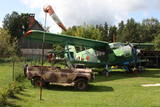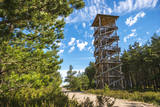| Nr | Nosaukums | Apraksts |
|---|---|---|
|
Braucot no Kandavas un Sabili, ceļa labajā pusē izveidots stāvlaukums, no kura ved kāpnes uz skatu laukumu Abavas senlejas augstākās vietas – Greiļu kalna nogāzē. No tās paveras viens no labākajiem senlejas skatiem ar pļavu un mežu mozaīku. Ainavu bagātina otrā senlejas pusē esošās Imulas un Amulas ielejas.
|
||
|
Līvānu kā lielākas apdzīvotas vietas pirmsākumi ir saistāmi ar 1533. g., kad toreizējais zemes īpašnieks Līvens izveidoja muižu un nosauca to savā vārdā par Līvenhofu. 1678. g. šeit tapa pirmā katoļu baznīca. Pilsēta būtiski cieta abu pasaules karu laikā. Līvānu vārds saistās ar stikla izstrādājumiem. 1887. g. šeit dibināja stikla fabriku, kas mūsdienās ir pārtraukusi savu darbību. |
||
|
Zemnieku saimniecība „Kronīši” atrodas Limbažu novada Viļķenes pagastā. Saimniecībā tiek audzēti bioloģiskie dārzeņi, kas tiek pārstrādāti dažādos mājas konservos. No bioloģiskajām pļavām vāktiem augiem tiek ražotas tējas, piedāvājumā arī ievārījumi, konservi, sīrupi un sulas. Augļi un ogas tiek ievākti no pašu dārza, kā arī no vietējiem zemniekiem un blakus esošā Rūstužu un Blomes purva. Saimniecībā uzņem tūristu un pieredzes apmaiņas grupas ar iepriekšēju pieteikšanos. Ģimenes pasākumiem, t.sk. bērnu ballītēm, radošām darbnīcām un citām aktivitātēm pieejams tējas namiņš. |
||
|
Brīvdienu mājiņas Jūvgumegi atrodas Kurzemes reģiona Mazirbē, Slīteres nacionālajā parkā. Viesiem tiek piedāvātas četrvietīgas un divvietīgas naktsmītnes ar bezmaksas privātu autostāvvietu. Visās ir pieejama virtuve ar ledusskapi un plīts virsmu, kā arī tualete, duša izvietota uz terases. Līdz liedagam 400m. |
||
|
Saimniecībā žāvē cūkgaļu, taisa asinsdesas un ražo citus gaļas izstrādājumus. Saimnieks piedāvā ekskursiju un žāvējumu iegādi. |
||
|
Piedāvā pirts rituālus ar sildīšanu un pēršanu ar slotām, kontrasta procedūrām, dažādām maskām un augu skrubjiem. Saimniecībā ražo un popularizē ārstniecības augu lietošanas tradīcijas. Piedāvājumā dažādas zāļu tējas. Atkarībā no gadalaika, iespējams baudīt un iegādāties dažādus augu sīrupus. Izgatavo zāļu paklājus pirtij. |
||
|
Gleznainajos Viesatas upes krastos variet iziet dabas takas un sarīkot pikniku dabā. Izstaigājot dabas taku būs iespēja apskatīt upes stāvkrastus, 200 gadu vecu priedi, brūno avotiņu, cūku vannu, bebru māju, mežizstrādes laukumu, melnalkšņu audzi, dižbērzu, Spuņņakmeni un daudzus citus objektus. Ja būsiet īpaši vērīgi, varēsiet ieraudzīt arī dažādu sugu putnus par kuriem informāciju varēsiet atrast takā izvietotajos stendos. Takas garums vienā virzienā ir 5,1 km, un to iespējams iziet 3 dažādos variantos. Taka ir marķēta un izstaigājama arī bez pavadoņa palīdzības. Lai izstaigātu visus upes līkumus, būs nepieciešamas 3 - 4 stundas. |
||
|
Baltijas valstīs lielākais alpaku (Dienvidamerikas kalnu reģionu dzīvnieks) ganāmpulks. Interesenti var apskatīt dzīvniekus, noklausīties stāstījumu un iegādāties alpaku vilnu. 2014. gadā ganāmpulku plāno pārvietot no Vīcežu muižas Lībagu pagastā.
|
||
|
Ideja par "DA'ZIEPE" radās iedvesmojoties no Amatas novada dabas un idejas par pilnvērtīgu pieejamo resursu izmantošanu. Ziepes tiek gatavotas no liellopu vai briežu taukiem, augu eļļām un ziepju zālēm, kā arī papildinātas ar dažādām ēteriskajām eļļām un dabīgajiem aromātiem. |
||
|
Neliela apdzīvota un ainaviska vieta plašajā Skrobļa (Skroblus) strauta ielejā. Ciema austrumu pusē atrodas Lietuvas mērogā unikāls objekts – klēts - rija, kur no 1929. g. vietējie cilvēki uzveda un skatījās lauku teātra izrādes. Netālu no tās (uz abiem objektiem ir norādes) atrodas Skrobļa avoti (Skroblaus versmės), kas iztek no dziļas starppauguru ieplakas. Avotu gan ir appludinājis bebru uzceltais dambis. Dienvidos no ciema atrodas vecs grants karjers, kas ir viena no retajām vietām Baltijā, kur dabā ir atrodami krama ieža gabali, kas atnesti ar ledāju. |
||
|
Lokveida taku var iziet tikai Slīteres nacionālā parka gida pavadībā, jo tā izveidota dabas rezervāta zonā. Pa stāvajām kāpnēm, kas izveidotas Baltijas ledus ezera senkrastā, nokāpsim citā pasaulē, kur var iepazīt nogāžu un platlapju mežus, avoksnāju, kaļķainu zāļu purvu (visi – aizsargājami biotopi), kā arī senas meliorācijas grāvju atliekas un trupējošus egļu stumbrus (svarīgi sugu daudzveidībai), kas saglabājušies no 1969. gada orkāna laikiem. Taka sākas pie Šlīteres bākas. |
||
|
Saimniecības pirmsākumi meklējami 1992. gadā. Produkcijas gatavošanā tiek izmantots pašu audzētās govs piens. Piedāvā ekskursiju pa saimniecību, produkcijas degustāciju un iegādi. Var pasūtīt sierus. |
||
|
Vienīgā Latvijas kafejnīca, kurai ir ļoti neparasts - militārās tehnikas un citu atribūtu, t.sk. - Padomju armijas interjers. Arī tās dārzā ir apskatāmi interesanti eksponāti - artilērijas šāviņi, lidmašīna, kara automašīnas u.c. Tiešām vērts ieiet un izdzert kafiju.
|
||
|
Aptuveni 0,5 km dienvidos no Mežotnes pilskalna atrodas Vīna kalns, kas līdzīgi kā Mežotnes pilskalns, ir veidots, izmantojot Lielupes ielejas stāvās krastu nogāzes, tās pārveidojot. Vietvārds ir it kā radies no stāsta, ka šeit parādījies dievgalds ar maizi un vīnu. Vīna kalnu ar Mežotnes pilskalnu savieno jauka koka laipa, kas ved pa Lielupes ielejas pamatkrasta lejas daļu. |
||
|
Atrodas 0,9 km no Jaunpiebalgas muižas pils, Jaunpiebalgas centra virzienā. Redzot šo ēku, nav jāpārliecina, ka tā ir viena no garākajām Vidzemē. Tik gara, ka grūti pat „iedabūt kadrā”. |
||
|
Meklējama starp Bānūžu un Ilzes ezeriem. Vienreizējs koka celtniecības paraugs, kas tapis iepriekšējā dievnama vietā - 1780. g. Baznīca celta guļbūves tehnikā un līdz pat 20. gs. sākumam ēkai bijis salmu jumts, ko pēcāk nomainīja ar koka šķindeļiem. Torni piebūvēja 1911. g. 1994. g. atjaunoja baznīcas torni. Unikāli ir baznīcas logi, kas saglabājušies no 18. gs. Altāris, kancele un ērģeļu prospekts izgatavots 1893. g. Pie baznīcas uzņemtas mākslas filmas “Aija” ainas. Apskatāma arī no iekšpuses. |
||
|
Koka skatu tornis atrodas blakus Kolkasraga priežu takai. No tā redzama ar priedītēm aizaugusi „stiga” – t.s. Šautuve, kuru padomju laikā izmantoja šaušanas apmācībām. No torņa skatu platformas labi saskatāma Kolkas bāka, kas atrodas 5 km attālumā no Kolkasraga. |
||
|
Atrodas pie tilta (Akadēmijas iela 1) pār Lielupi. 1574. g. pēc Kurzemes – Zemgales hercoga Gotharda Ketlera pavēles uzsāk jaunas baznīcas celtniecību. Dievnama tornis tapa laikā no 1686. g. – 1688. g., bet 1862. g. to paaugstināja līdz 80,5 m. Baznīca nodega padomju aviācijas uzlidojuma laikā 1944. g. 27. jūlijā. 1954. g. Padomju armijas sapieri uzspridzināja ēkas atliekas. 2009. g. sākās baznīcas torņa rekonstrukcija un šobrīd tajā izveidots izcils interaktīvais muzejs (īpaši draudzīgs bērniem) un stiklota skatu platforma. |
||
|
No mazpazīstamā pilskalna skatu stigas paveras viens no Vidzemes neparastākajiem skatiem uz Augstrozes Lielezeru. Pilskalnā slejas pilsdrupas, kuru apskates nolūkā izveidota neliela taka. Atrodas ZBR.
|
||
|
Krodziņš „Četri vēji” atrodas Rīgas - Liepājas autoceļa (A9) 72. km. Krodziņā tiek piedāvāti dzīvās mūzikas vakari. Latviešu virtuve: Vidzemes salāti, siļķe ar biezpienu un krējumu, pelēkie zirņi ar speķi, sautēti kāposti ar desiņām, kāpostu tīteņi, kartupeļu pankūkas, maizes zupa, rupjmaizes kārtojums. Īpašais ēdiens: „4 vēji” – cūkgaļa ar štovētiem kāpostiem un kartupeļiem uz karstas pannas. |
||






















